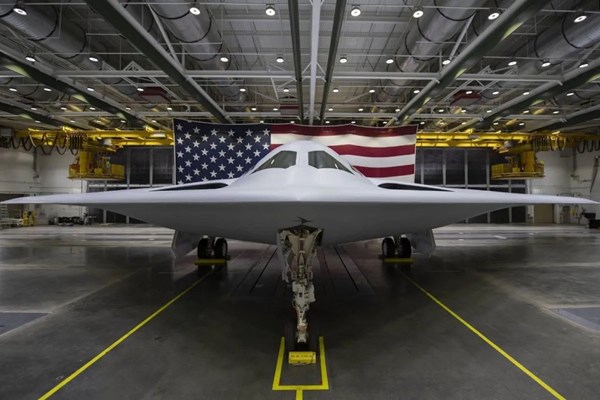Last week, multiple media outlets covered the unveiling of the B-21 Raider, the first new US bomber design in 30 years.
Although there is still scant publicly available information about the new military aircraft, the US Department of Defense (DOD) mentions that the B-21 is part of a family of systems intended for long-range strikes, which includes intelligence gathering, surveillance, reconnaissance, electronic attack, communication and other capabilities.
The DOD has also said that the B-21 is capable of battle management and interoperability with US allies and partners.
The US Air Force describes the B-21 as a long-range, survivable stealth bomber capable of launching conventional and nuclear munitions, with 100 units slated to be built at the cost of US$692 million per plane. Air Force Spokeswoman Ann Stefanek stated that the plane’s first test flight is slated for 2023, as reported by CNN last week.
Northrop Grumman, the plane’s manufacturer, touts the B-21 as the first sixth-generation combat aircraft featuring stealth, information advantage and open architecture. It also emphasizes that the B-21 can network to multiple systems and in all domains, and is future-proofed by rapid software upgrades to outpace evolving threats.
Joseph Trevithick and Tyler Rogoway note in The Warzone that the B-21 appears to have enough internal space for at least one GBU-57/B Massive Ordnance Penetrator (MOP), representing about half the payload of a B-2 Spirit bomber, which can carry 18,144 kilograms.
It is also likely that the B-21 will carry stealthy long-range cruise missiles as its B-2 predecessor .This September, Asia Times reported on the successful launch of the Joint Air-to-Surface Standoff Missile-Extended Range (JASSM-ER) from the B-2 bomber. This upgrade, or the Long Range Antiship Missile (LRASM), gives the B-2 long-range anti-ship capabilities, which the B-21 will also likely possess.
The B-21 fills key capability gaps in the US strategic bomber force, including the need to penetrate heavily defended airspace, replace aging bombers and restart strategic bomber production.
The B-52 Stratofortress is showing its age despite numerous upgrades that aim to keep it flying into the 2050s. Significantly, its non-stealthy design gives it limited utility in penetrating heavily defended airspace.
Although the B-1 Lancer supersonic bomber was slated to replace partially the B-52, maintenance issues have forced handicaps on its capability and early retirement.
Oriana Pawlyk notes on Military.com that due to wear and tear from close air support missions in Afghanistan and Iraq, the B-1 fleet is now restricted in using low-altitude supersonic flight to avoid enemy air defenses, which removes the primary rationale for its design. Pawlyk notes that, because of these issues, the B-1 fleet will be retired in 2036.
The US still operates the B-2 Spirit stealth bomber, the direct design predecessor of the B-21. Made to evade Soviet air defenses while flying at low subsonic speed, the cost-death spiral associated with the B-2 capped production at just 21 planes when production was stopped in 2020, with restarting production deemed too costly to be feasible.
As noted by Jacopo Prisco in CNN, the B-2 cost US$2 billion per aircraft in 2020 US dollars, in contrast to the B-21’s US$692 million projected per unit cost.
The B-21 also represents a marked improvement from its B-2 predecessor in terms of maintenance, which offers increased combat readiness and availability. While the B-2 was ahead of its time, its radar-absorbing skin is sensitive to all but the calmest weather, needs special climate-controlled hangars, requires 51 hours of ground maintenance for every hour in the air, costs US$150,000 for every fight hour, as noted by W J Hennigan in Time.
In contrast to the B-2, Hennigan notes that the B-21 can be left outside in a flight shelter just like any other aircraft and that mechanics can open doors to access wiring, removing the need to scrape off stealth coating first.
Although the US Air Force stated that the B-21 is designed to accommodate manned or unmanned operations, Kelley Salyer and Paul Scharre note in Defense One report that the capacity is not a priority in the B-21’s current development cycle and that the US may not incorporate the dual capability into early B-21 units.
Despite that, Salyer and Scharre argue that the US should have initially incorporated unmanned capabilities into the B-21, which they said would make it free from human pilot limitations for just a marginal cost increase.
Asia Times has previously noted that covert SEAL teams or mini-submarines operating on or near South China Sea features can act as target designators for air and missile strikes against enemy warships and island fortifications.
For example, an unmanned B-21 can loiter above surface and ground units, with SEAL teams, mini-subs or drones calling in precision strikes on these within seconds.
Moreover, Salyer and Scharre note that the US can use the B-21 to attack China’s DF-21 anti-ship ballistic missile launchers, loitering for prolonged periods at standoff range and then engaging these time-sensitive targets as they emerge from concealment or from their hardened shelters.
The Pacific’s vast distances may restrict the use of carrier-launched stealth drones such as the prototype X-47B to spot or attack targets for long-range strikes in contested airspace. For example, the relatively short range of the X-47B may force US carrier battlegroups to operate closer to the range of China’s anti-ship ballistic missiles, placing them at risk of attack.
Although the US operates long-range drones such as the RQ-4, its non-stealth design and low speed make it suboptimal for operating in contested airspace. Because the RQ-4 is an unarmed drone, it lacks the capacity to attack targets of opportunity as they are detected.
Capable of operating from airfields and bases relatively out of missile attack range from China, the B-21 aims to solve these limitations through its long range, stealth capabilities, high subsonic speed and standoff weapons, aimed altogether at penetrating air defense zones and attacking strategic targets and assets at standoff ranges.
Source: Asia Times








